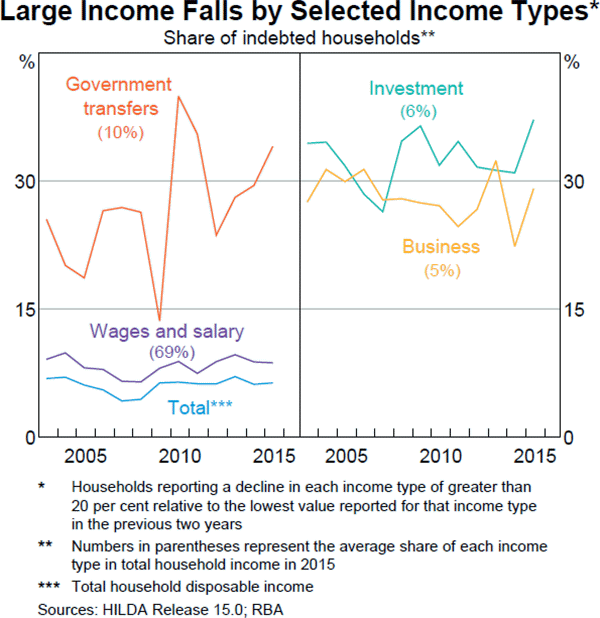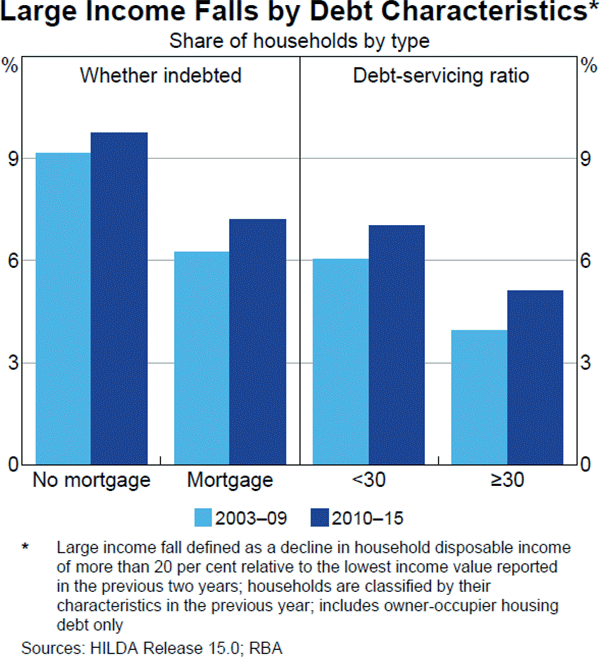Financial Stability Review – October 2017 Box C: Large Falls in Household Income
Households that experience large income falls can struggle to meet mortgage repayments. This box uses annual data from the Household, Income and Labour Dynamics in Australia (HILDA) Survey to look at the typical characteristics of households that experience large declines in income. It focuses mainly on households with owner-occupier housing debt as HILDA data on investor housing debt are only available every four years. Overall, on average the households that are more likely to experience large falls in income tend to be those with lower debt-servicing burdens or higher incomes and so are best able to continue servicing their financial debts, though there is clearly a range of experiences.
Households with Large Income Falls
In this box, households are classified as having a ‘large’ income fall if their annual disposable income declines by more than 20 per cent relative to their minimum income level over the previous two years. This definition abstracts from large income falls that reflect the unwinding of temporary income gains such as redundancy payments. Based on this measure, HILDA data indicate that, on average, around 6 per cent of indebted households experience large declines in their total disposable income in any given year (Graph C1).

Households receive income from a range of sources, some of which are more volatile and hence more likely to experience large declines (and large rises). For example, around 30 per cent of households earning business or investment income (which includes rent from investment properties) reported large declines in these income types in a given year, even though these types of income are only a relatively small share of total household income.[1] For this reason, APRA expects lenders to apply a discount (or ‘haircut’) to volatile income sources when assessing a borrower's income.[2] Further, while a substantial share of households experience annual declines in transfer income (especially government assistance payments), these declines are often accompanied by increases in wage and salary income.
While wage and salary income comprises around 70 per cent of total household income on average, less than 10 per cent of households reported large annual declines in this type of income. However, given that wage and salary income makes up a sizeable proportion of total income, large declines in households' total disposable income are in practice most commonly driven by falls in wage and salary income. HILDA data suggest that two drivers of large declines in wage and salary income are household members becoming unemployed or dropping out of the labour force, for instance due to child care and/or retirement, and relationship breakups, such as divorce, which change household composition or reduce a household's overall income.[3]
Experiencing a sizeable decline in household income does not necessarily imply that a household will struggle to repay its debts. Some households plan for income falls, such as choosing to leave the workforce to study, have a child or retire. Households with low debt relative to income – for example those who initially borrowed small amounts or whose income has grown since they took out the debt – may have sufficient disposable income to still make their debt repayments. Other households may have accumulated funds through pre-payments that can be drawn on to smooth through temporary falls in income. Nonetheless, households experiencing large income declines are more likely to experience mortgage stress; the characteristics of these households are outlined below.
Household Characteristics
Two characteristics associated with households experiencing large income declines are the income quintile of the household and the employment type of the household head. More households in the top income quintile report large declines in income than other households (Graph C2; left panel). This appears to partly reflect that high-income households typically earn a greater share of their income from investment and business income, both of which tend to be more volatile than other sources of income. Nonetheless, higher-income households are still likely to be better placed to service their debts than low-income households even after experiencing a large income fall. In contrast, fewer households in the bottom income quintile experience large income declines, partly because more of their income tends to come from relatively stable sources.

Households with self-employed heads are also more likely to experience large income falls (Graph C2; right panel). These households, on average, earn a much higher share of their total income from volatile business income (20–25 per cent) compared with other households (1–2 per cent). Similarly, households in which the head works part time are more likely to experience large income declines compared with households where the head works full time.
Households with owner-occupier mortgage debt are less likely to experience large income falls than those without mortgage debt (Graph C3). Further, the HILDA data suggest that of households with owner-occupier debt, the more indebted households are less likely to experience large income falls. Specifically, the share of households with debt-servicing ratios (DSRs) above 30 per cent that report large declines in income is lower than for households with lower DSRs.[4] It is not clear to what extent this reflects that households with volatile income borrow less (either by choice or because of the lending policies of financial institutions, such as applying a haircut to volatile income sources) or whether households seek out more stable forms of income before or soon after borrowing. In addition, households with higher DSRs are less likely to choose to cut down their working hours or to exit the labour force.

These observations, however, do not necessarily imply that households with greater debt-servicing burdens are less likely to suffer mortgage distress. Previous research has found that households with high DSRs are more likely to miss mortgage repayments.[5] One way to reconcile these results is that, while households with high DSRs are less likely to suffer large income declines than households with low DSRs, if they do experience a sharp fall in income, they are much more likely to experience financial stress.
Footnotes
The large spike for transfer income during the financial crisis period was likely due to the unwinding of the various temporary bonus payments made by the federal government. [1]
APRA notes that it is prudent practice for lenders to apply a discount of at least 20 per cent on most types of non-salary income such as bonuses, overtime, rental income and other investment income. See APRA (2017), ‘APG 223 Residential Mortgage Lending’, Prudential Practice Guide, February. [2]
Over the sample period, roughly 15–20 per cent of households experiencing large declines had a household member who reported a transition from being employed to being unemployed or not in the labour force from one year to the next. This does not include shorter-term episodes of labour market transition that are reversed within one year, which can also negatively impact household income. [3]
The DSR is the share of disposable income devoted to meeting repayments. Over the sample period, a DSR above 30 per cent corresponds to around the 75th percentile of the DSR distribution. [4]
See Read M, C Stewart and G La Cava (2014), ‘Mortgage-related Financial Difficulties: Evidence from Australian Micro-level Data’, RBA Research Discussion Paper No 2014–13. [5]